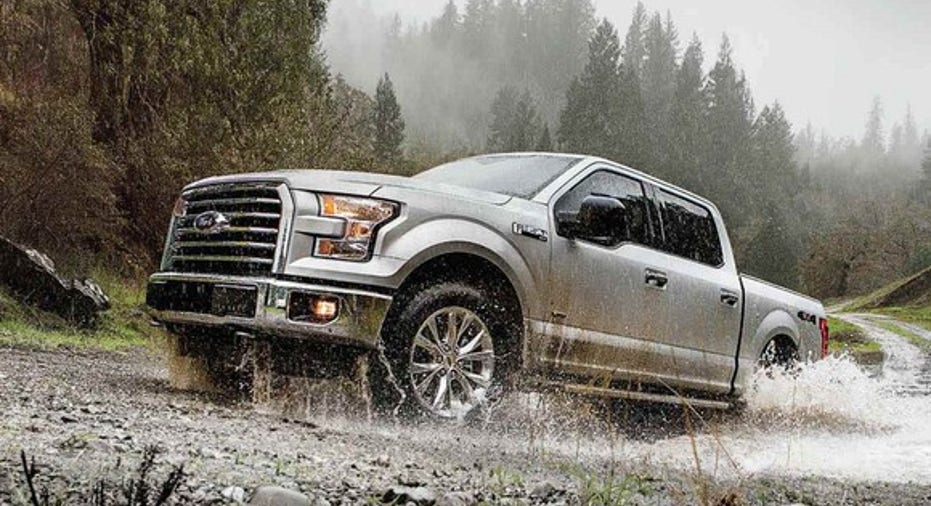This Used Car Is Worth More Now Than When New

Demand for Harley-Davidson (NYSE: HOG) motorcycles used to be so great that a used bike could be sold for as much or more than the price paid for it. Waiting lists to buy new motorcycles ran months long until Harley went into overdrive producing enough bikes to meet demand.
You're usually not going to find a comparable situation in production-model cars and trucks. Their ubiquity makes them, if not a dime a dozen, certainly less valuable over time. That's partially the reason a car's value drops so sharply once you drive it off the dealer's lot. A Ford (NYSE: F) F-150 pickup truck may be the best-selling vehicle on the market today, but Kelley Blue Book says a model year 2016 F-150 has already lost 11% of its value, or some $2,083, at auction.
Image source: Ford.
Gas-guzzlers make a comeback
Recently, Kelley released its fourth-quarter 2016 survey on retention values for manufacturer-suggested retail prices when a car that's anywhere from one to three years old goes to auction. It found that full-sized pickup trucks like Ford's have done surprisingly well at holding onto their value, with the F-150 coming in fifth among the competition, but the Nissan (NASDAQOTH: NSANY) Titan is doing best overall, losing just 2% of its value.
However, the report took a closer look at model year 2015 vehicles to see those that retained values best, and apparently, lower gas prices were having a big effect on buyer choices: The two worst-performing segments were subcompact cars that retained just 51% of their value and electric cars, which only managed to hold onto 38%.
The worst of the worst were General Motors' (NYSE: GM) hybrid electric Chevy Volt, keeping just 40% of its value; the subcompact Mitsubishi Mirage and smart fortwo, at just 39% and 37%, respectively; and the all-electric Nissan Leaf, which, at just 24%, was unable to retain even a quarter of its value at auction.
Part of the Leaf's problem, despite being the world's best-selling EV and receiving generally favorable reviews from sites, including Kelley Blue Book,was its limited range on a charge, which at its peak is just 84 miles. That's not very practical, and after Tesla (NASDAQ: TSLA) began taking reservations for its $35,000 Model 3, that put a huge dent in Leaf sales, which dropped 19% between 2015 and 2016.So, it's understandable why the car can't hold any value at auction.
Image source: Nissan.
Better performance, better value
However, not all small vehicles did poorly. The SUV/Crossover segment, for example, regardless of its price range, ranked among the best performers for the 2015 model year, with four spots on the top 10 list. The Jeep Wrangler and Nissan Xterra retained 87% and 83% of their values, respectively, placing them fourth and fifth in the top 10 models for the year, while the luxury versions of the the Porsche Cayenne andLand Rover Range Rover Sport also ranked highly, coming in third place and sixth, respectively, with retained values of 89% and 82%.
Perhaps not surprisingly, luxury vehicles did best overall, taking six of the 10 slots overall, with the high-performance segment having the second highest retention rate among all vehicles, at 74%. Kelley Blue Book says it was the only segment to finish the year having increased its retention value.
Yet only two high-performance vehicles made the list, the Audi R8, which did well by retaining 80% of its value, though that was only good enough for tenth place, and the one car that actually rose in value: the Mercedes-Benz SLS-class supercar.
Image source: Mercedes-Benz.
A rare find
Although this vehicle has earned superlatives since its introduction in 2010, and Kelley saw the 2015 model as a worthy competitor to the Aston Martin DB9, Ferrari California, and Bentley Continental GT,it may be that Mercedes put its finger on the scale for its $200,000-plus gull-wing supercar, because 2015 was the last year the SLS AMG (Mercedes'high-performance division) would be produced. It was subsequently replaced by the GT AMG.
The SLS featured a 6.2-liter M159 V-8 engine that offered 583 horsepower at 6800 rpm, and went from 0 to 60 mph in 3.7 seconds. It was also a limited-production car, with just 350 vehicles made, and with all the raves the vehicle enjoyed over its run, naming it the Final Edition certainly ensured it would be a sought-after vehicle for years to come.
So, it might not be fair to put the SLS up against the No. 2 performer in vehicle value retention, the mid-size Toyota Tacoma Double Cab pickup, which kept 89% of its value, but production vehicles growing in value is enough of a rarified event to warrant mention. Certainly as Harley-Davidson struggles to sell its motorcycles these days, even if a used Hog still carries a premium, Mercedes Benz can at least bask in the performance of its supercar and see its value continue to grow in the years to come.
10 stocks we like better thanWal-MartWhen investing geniuses David and TomGardner have a stock tip, it can pay to listen. After all, the newsletter theyhave run for over a decade, the Motley Fool Stock Advisor, has tripled the market.*
David and Tomjust revealed what they believe are the10 best stocksfor investors to buy right now...and Wal-Mart wasn't one of them! That's right -- theythink these 10 stocks are even better buys.
Click hereto learn about these picks!
*StockAdvisor returns as of March 6, 2017.The author(s) may have a position in any stocks mentioned.
Rich Duprey has no position in any stocks mentioned. The Motley Fool owns shares of and recommends Ford and Tesla. The Motley Fool recommends General Motors. The Motley Fool has a disclosure policy.